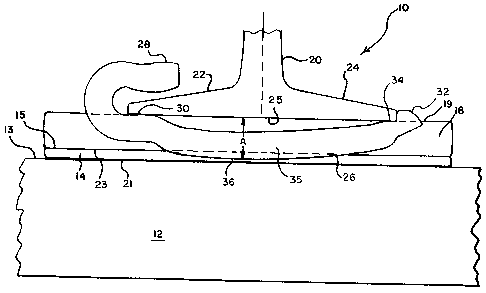Some of the information on this Web page has been provided by external sources. The Government of Canada is not responsible for the accuracy, reliability or currency of the information supplied by external sources. Users wishing to rely upon this information should consult directly with the source of the information. Content provided by external sources is not subject to official languages, privacy and accessibility requirements.
Any discrepancies in the text and image of the Claims and Abstract are due to differing posting times. Text of the Claims and Abstract are posted:
| (12) Patent: | (11) CA 2697603 |
|---|---|
| (54) English Title: | RAIL ANCHOR |
| (54) French Title: | ANTICHEMINANT |
| Status: | Granted and Issued |
| (51) International Patent Classification (IPC): |
|
|---|---|
| (72) Inventors : |
|
| (73) Owners : |
|
| (71) Applicants : |
|
| (74) Agent: | SMART & BIGGAR LP |
| (74) Associate agent: | |
| (45) Issued: | 2013-04-02 |
| (22) Filed Date: | 2010-03-23 |
| (41) Open to Public Inspection: | 2011-01-10 |
| Examination requested: | 2010-03-23 |
| Availability of licence: | N/A |
| Dedicated to the Public: | N/A |
| (25) Language of filing: | English |
| Patent Cooperation Treaty (PCT): | No |
|---|
| (30) Application Priority Data: | ||||||
|---|---|---|---|---|---|---|
|
A rail anchor and a rail anchor assembly are provided for use with a concrete railroad tie. An elastomeric plate is placed on a top surface of the railroad tie. A rigid plate is placed on top of the elastomeric plate. The rail anchor is placed adjacent the elastomeric plate and the rigid plate. The rail anchor has a first end with a receiving opening and a second end with a receiving indentation to receive edges of the flanges of the railroad rail. The rail anchor has a centre portion joining the two ends. The outer portion of the rail anchor extends downwardly an amount less than the thickness of the elastomeric plate and the rigid plate to avoid contact with the concrete railroad tie.
Un anticheminant et un ensemble anticheminant destinés à être utilisés avec une traverse de chemin de fer en béton. Une plaque élastomère est mise sur une surface supérieure de la traverse de chemin de fer. Une plaque rigide est mise sur le dessus de la plaque élastomère. L'anticheminant est placé de façon adjacente à la plaque élastomère et à la plaque rigide. L'anticheminant possède une première extrémité munie d'une ouverture de réception et d'une seconde extrémité munie d'une indentation de réception pour recevoir les bords des patins du rail de la voie ferrée. L'anticheminant possède une partie centrale qui relie les deux extrémités. La partie extérieure de l'anticheminant s'étend vers le bas d'une distance inférieure à l'épaisseur de la plaque élastomère et de la plaque rigide pour éviter le contact avec la traverse de chemin de fer en béton.
Note: Claims are shown in the official language in which they were submitted.
Note: Descriptions are shown in the official language in which they were submitted.

2024-08-01:As part of the Next Generation Patents (NGP) transition, the Canadian Patents Database (CPD) now contains a more detailed Event History, which replicates the Event Log of our new back-office solution.
Please note that "Inactive:" events refers to events no longer in use in our new back-office solution.
For a clearer understanding of the status of the application/patent presented on this page, the site Disclaimer , as well as the definitions for Patent , Event History , Maintenance Fee and Payment History should be consulted.
| Description | Date |
|---|---|
| Letter Sent | 2024-03-25 |
| Common Representative Appointed | 2019-10-30 |
| Common Representative Appointed | 2019-10-30 |
| Appointment of Agent Requirements Determined Compliant | 2016-10-26 |
| Inactive: Office letter | 2016-10-26 |
| Inactive: Office letter | 2016-10-26 |
| Revocation of Agent Requirements Determined Compliant | 2016-10-26 |
| Letter Sent | 2016-10-19 |
| Letter Sent | 2016-10-19 |
| Appointment of Agent Request | 2016-10-13 |
| Revocation of Agent Request | 2016-10-13 |
| Inactive: Late MF processed | 2016-06-22 |
| Letter Sent | 2016-03-23 |
| Letter Sent | 2015-08-03 |
| Grant by Issuance | 2013-04-02 |
| Inactive: Cover page published | 2013-04-01 |
| Inactive: Final fee received | 2013-01-09 |
| Pre-grant | 2013-01-09 |
| Letter Sent | 2013-01-02 |
| Notice of Allowance is Issued | 2013-01-02 |
| Notice of Allowance is Issued | 2013-01-02 |
| Inactive: Approved for allowance (AFA) | 2012-12-20 |
| Amendment Received - Voluntary Amendment | 2012-08-13 |
| Inactive: S.30(2) Rules - Examiner requisition | 2012-08-06 |
| Application Published (Open to Public Inspection) | 2011-01-10 |
| Inactive: Cover page published | 2011-01-09 |
| Inactive: First IPC assigned | 2010-06-22 |
| Inactive: IPC assigned | 2010-06-22 |
| Inactive: Office letter | 2010-05-04 |
| Application Received - Regular National | 2010-04-28 |
| Filing Requirements Determined Compliant | 2010-04-28 |
| Letter Sent | 2010-04-28 |
| Letter Sent | 2010-04-28 |
| Inactive: Filing certificate - RFE (English) | 2010-04-28 |
| All Requirements for Examination Determined Compliant | 2010-03-23 |
| Request for Examination Requirements Determined Compliant | 2010-03-23 |
There is no abandonment history.
The last payment was received on 2013-01-25
Note : If the full payment has not been received on or before the date indicated, a further fee may be required which may be one of the following
Please refer to the CIPO Patent Fees web page to see all current fee amounts.
Note: Records showing the ownership history in alphabetical order.
| Current Owners on Record |
|---|
| PROGRESS RAIL SERVICES CORPORATION |
| Past Owners on Record |
|---|
| CASEY WALSH |
| ED BOSSHAMMER |
| JIM HENDERSON |